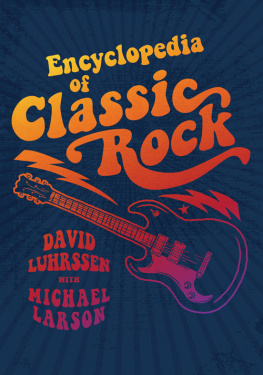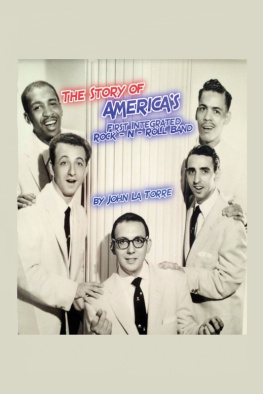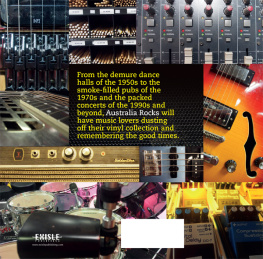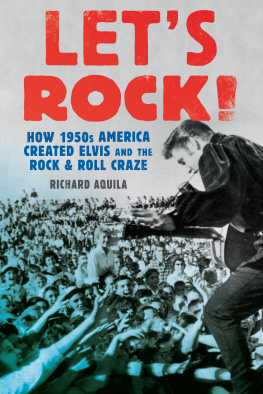FIVE YEARS AHEAD OF MY TIME

The REVERB series looks at the connections between music, artists and performers, musical cultures and places. It explores how our cultural and historical understanding of times and places may help us to appreciate a wide variety of music, and vice versa.
reverb-series.co.uk
SERIES EDITOR: JOHN SCANLAN
Already published
The Beatles in Hamburg
IAN INGLIS
Brazilian Jive: From Samba to Bossa and Rap
DAVID TREECE
Easy Riders, Rolling Stones: On the Road in America, from Delta Blues to 70s Rock
JOHN SCANLAN
Gypsy Music: The Balkans and Beyond
ALAN ASHTON-SMITH
Five Years Ahead of My Time: Garage Rock from the 1950s to the Present
SETH BOVEY
Heroes: David Bowie and Berlin
TOBIAS RTHER
Jimi Hendrix: Soundscapes
MARIE-PAULE MACDONALD
Neil Young: American Traveller
MARTIN HALLIWELL
Nick Drake: Dreaming England
NATHAN WISEMAN-TROWSE
Peter Gabriel: Global Citizen
PAUL HEGARTY
Remixology: Tracing the Dub Diaspora
PAUL SULLIVAN
Sting: From Northern Skies to Fields of Gold
PAUL CARR
Tango: Sex and Rhythm of the City
MIKE GONZALEZ AND MARIANELLA YANES
Van Halen: Exuberant California, Zen Rocknroll
JOHN SCANLAN

SETH BOVEY
REAKTION BOOKS
Dedicated
to all garage bands everywhere
Published by Reaktion Books Ltd
Unit 32, Waterside
4448 Wharf Road
London N1 7UX, UK
www.reaktionbooks.co.uk
First published 2019
Copyright Seth Bovey 2019
All rights reserved
No part of this publication may be reproduced, stored in a retrieval system, or transmitted, in any form or by any means, electronic, mechanical, photocopying, recording or otherwise, without the prior permission of the publishers
Page references in the Photo Acknowledgements and
Index match the printed edition of this book.
Printed and bound in Great Britain by Bell & Bain, Glasgow
A catalogue record for this book is available from the British Library
eISBN 9781789140941
Contents

Introduction
The Pioneers: Instrumental Rock and the First Garage Combos
T he rock n roll craze died down as dramatically as it began, with most big-name performers being silenced or compromised by the end of the 1950s. As early as 1957, Little Richard shocked fans by deciding to leave the music business and enter the ministry. In 1958, Elvis Presley began his two-year hitch in the U.S. army, Gene Vincent lost his house and his band owing to financial difficulties and Jerry Lee Lewis was blacklisted from radio airplay after the press discovered that he had married his thirteen-year-old cousin, Myra Gala Brown. In 1959, a plane crash in Iowa killed Richie Valens, The Big Bopper and Buddy Holly. Chuck Berry was arrested under the Mann Act for transporting a fourteen-year-old girl across state lines for immoral purposes and, in 1960, was tried and convicted. That same year, Eddie Cochran was killed in Britain in a car accident that also severely injured Gene Vincents leg.
Rock n roll obviously survived these setbacks, but the mix of artists being promoted on Top 40 radio changed. Figures such as Bill Haley, Fats Domino and Bo Diddley continued to perform and produce hit records, but they were overshadowed in the marketplace by a horde of teen idols and white-bread pop singers. The airwaves were crowded with sappy love songs by the likes of Dion, Paul Anka, Bobbie Vee and Frankie Avalon as well as the tame pop numbers of Connie Francis and Pat Boone. Yet this situation was hardly static, for a couple of other developments were taking place at the
Both Eddy and Wray have risen to guitar hero status because of their innovations in modifying the sound of the electric guitar. Eddys gimmick was his so-called twangy sound, which was due partly to his technique and partly to sound effects. When Eddy was discovered as a teenager by producer Lee Hazlewood, he was a country musician who naturally had that string-bending country twang in his guitar licks. After being in the studio a few times, Eddy also hit upon the idea of playing melodies on the low strings, mainly because the bass notes recorded better than the treble ones.

As rocks first guitar hero, Duane Eddy inspired legions of young guitarists to play, and his twangy sound showed that the guitar could have an expressive voice.
The influence of musicians such as Eddy and Wray was enhanced by another development in the late 1950s: the increasing coverage of pop music on television. Many rock n rollers appeared on variety shows such as The Guy Mitchell Show, The Steve Allen Show and The Ed Sullivan Show, reaching a larger public than they could by simply having hit records and touring the dance halls. The teen dance shows had even more impact, and cities such as New York, Baltimore and Washington, DC, had their own such shows on local television stations, but it was Dick Clarks Philadelphia-based Bandstand that became the most influential one after ABC began broadcasting it nationwide in August 1957. By February 1958, the renamed American Bandstand averaged 8.4 million viewers a day, most of whom were teenagers and housewives, and by January 1959 it was the top daytime show in the country. This show gave viewers throughout America, no matter how remote from the urban centres, a chance to keep up with the latest hit records and dance steps and to see the hit-makers of the day perform. It also allowed them to see the performers interact with Clark, whose easy-going, congenial manner brought the stars down to earth and made them seem familiar; consequently, music fans began to feel more closely connected to the stars than they had through the mediums of radio and fan magazines.

Link Wray could be seen as the second guitar hero of rock, and he gave the guitars voice even more grain and texture through distorted power chords and extreme tone settings.
music in front of enthusiastic and appreciative studio audiences. Moreover, the instrumental stars played tunes that were relatively simple and easy to learn; a kid might not have the singing voice of a Dion or Paul Anka, but anyone with basic skills on an instrument could figure out the main parts of Raunchy or Rebel-Rouser. Thus young people throughout the country began entertaining the notion of learning an instrument or forming a rock n roll combo.
A television show of a different kind that encouraged youngsters to play rock n roll was The Adventures of Ozzie and Harriet, a sitcom that could be seen as a forerunner of todays reality shows. Ostensibly based on the real-life experiences of the Nelson family, the programme was produced, directed and written by father Ozzie and served as the platform that launched Ricky Nelsons musical career. As a youngster, Ricky took an interest in rock n roll, and when a girlfriend of his had a crush on Elvis, sixteen-year-old Ricky bragged that he was about to cut his own record and called upon his father to make it happen. Ricky then recorded a cover version of Fats Dominos Im Walkin while Ozzie produced an episode called Ricky the Drummer, which featured Ricky singing the song at a local dance; this episode aired in April 1957 the same week that Rickys single was released. The record sold 1 million copies in the first week, and for the next six years Ricky had a string of hits in the charts. At the same time, Rickys stupendous success, especially his appeal to girls, gave many teenage boys ideas about what could happen if they were to learn how to sing and play the guitar.














